Personal Leadership Report: Self-Assessment, Theories & Mindset Model
VerifiedAdded on 2023/05/29
|21
|5021
|354
Report
AI Summary
This report provides an in-depth analysis of personal leadership within an organizational context, focusing on the application of various leadership styles and theories. The study uses the Leadership Thinking/Mindset System model to evaluate different leadership mindsets and their impact on organizational performance. It explores leadership styles such as autocratic, democratic, and charismatic leadership, alongside theories like trait, behavioral, and situational contingency theories. The report includes a self-evaluation, highlighting the importance of communication, empathy, analytical skills, and influence in effective leadership. Furthermore, it examines the impact of leadership styles on employee performance, potential improvements, and personal leadership qualities within the organization, including strengths, areas for growth, and a plan for future role development. The analysis also aligns personal leadership styles with organizational needs and proposes a focus on sustainable and complex leadership mindsets for 21st-century business challenges. The report concludes with recommendations for enhancing leadership effectiveness within the organization.
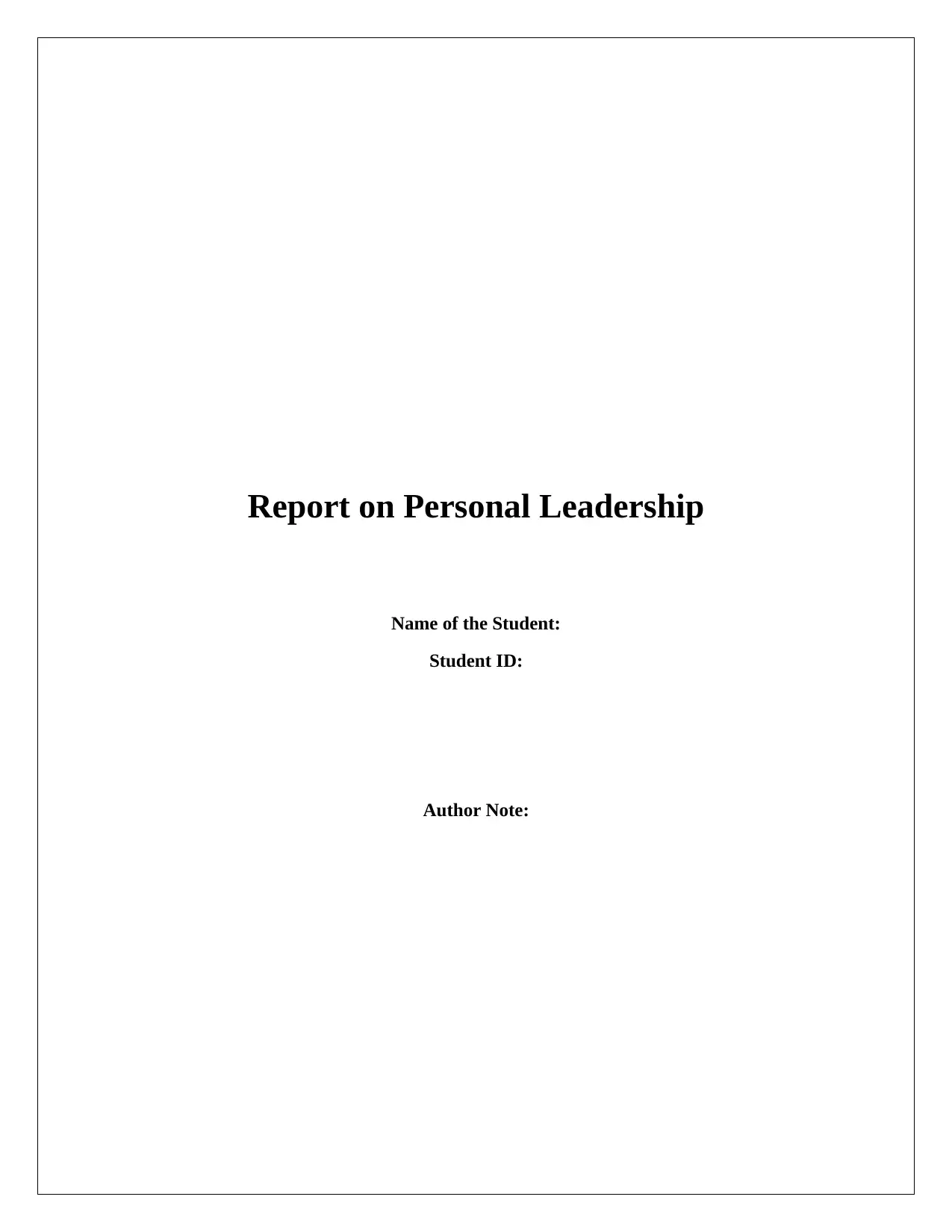
Report on Personal Leadership
Name of the Student:
Student ID:
Author Note:
Name of the Student:
Student ID:
Author Note:
Paraphrase This Document
Need a fresh take? Get an instant paraphrase of this document with our AI Paraphraser
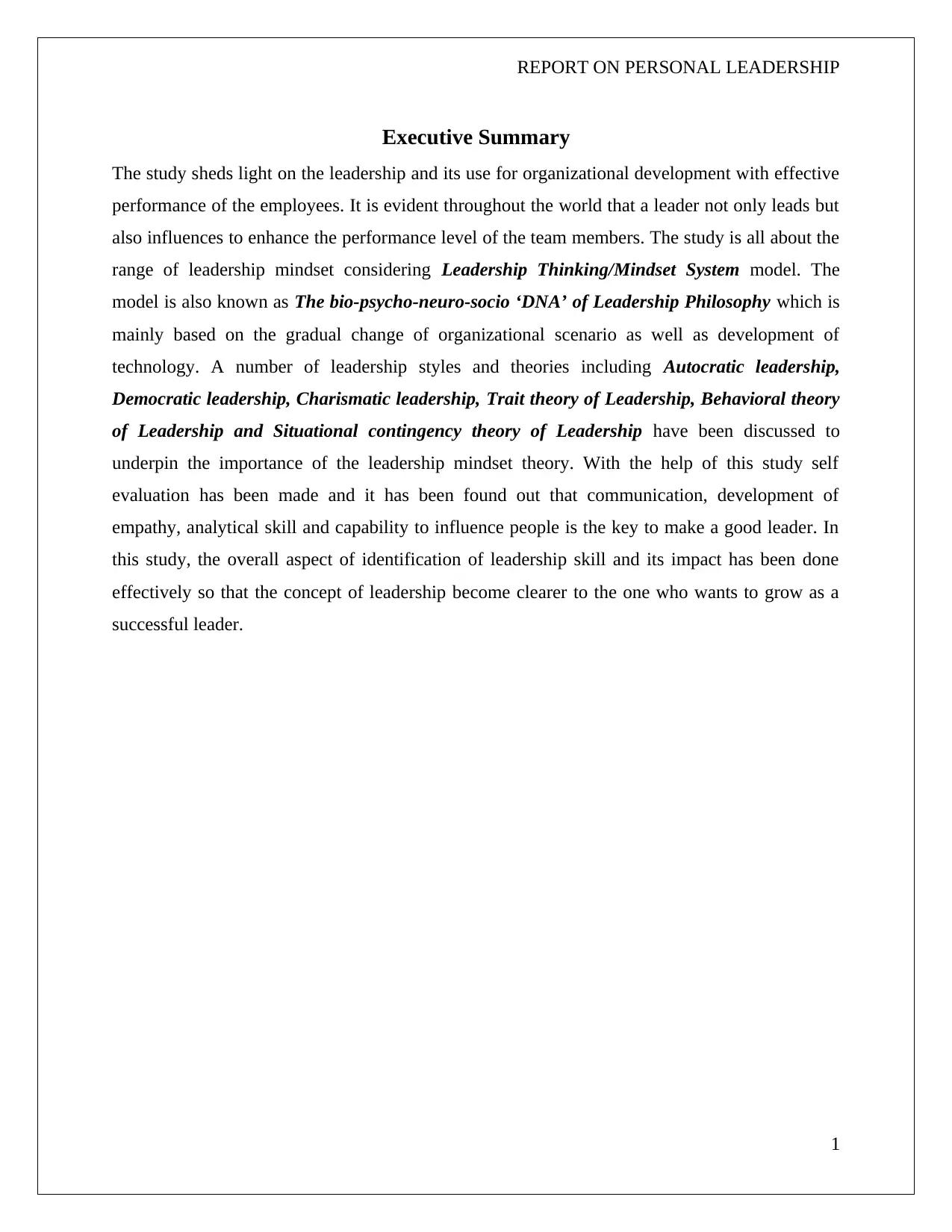
REPORT ON PERSONAL LEADERSHIP
Executive Summary
The study sheds light on the leadership and its use for organizational development with effective
performance of the employees. It is evident throughout the world that a leader not only leads but
also influences to enhance the performance level of the team members. The study is all about the
range of leadership mindset considering Leadership Thinking/Mindset System model. The
model is also known as The bio-psycho-neuro-socio ‘DNA’ of Leadership Philosophy which is
mainly based on the gradual change of organizational scenario as well as development of
technology. A number of leadership styles and theories including Autocratic leadership,
Democratic leadership, Charismatic leadership, Trait theory of Leadership, Behavioral theory
of Leadership and Situational contingency theory of Leadership have been discussed to
underpin the importance of the leadership mindset theory. With the help of this study self
evaluation has been made and it has been found out that communication, development of
empathy, analytical skill and capability to influence people is the key to make a good leader. In
this study, the overall aspect of identification of leadership skill and its impact has been done
effectively so that the concept of leadership become clearer to the one who wants to grow as a
successful leader.
1
Executive Summary
The study sheds light on the leadership and its use for organizational development with effective
performance of the employees. It is evident throughout the world that a leader not only leads but
also influences to enhance the performance level of the team members. The study is all about the
range of leadership mindset considering Leadership Thinking/Mindset System model. The
model is also known as The bio-psycho-neuro-socio ‘DNA’ of Leadership Philosophy which is
mainly based on the gradual change of organizational scenario as well as development of
technology. A number of leadership styles and theories including Autocratic leadership,
Democratic leadership, Charismatic leadership, Trait theory of Leadership, Behavioral theory
of Leadership and Situational contingency theory of Leadership have been discussed to
underpin the importance of the leadership mindset theory. With the help of this study self
evaluation has been made and it has been found out that communication, development of
empathy, analytical skill and capability to influence people is the key to make a good leader. In
this study, the overall aspect of identification of leadership skill and its impact has been done
effectively so that the concept of leadership become clearer to the one who wants to grow as a
successful leader.
1
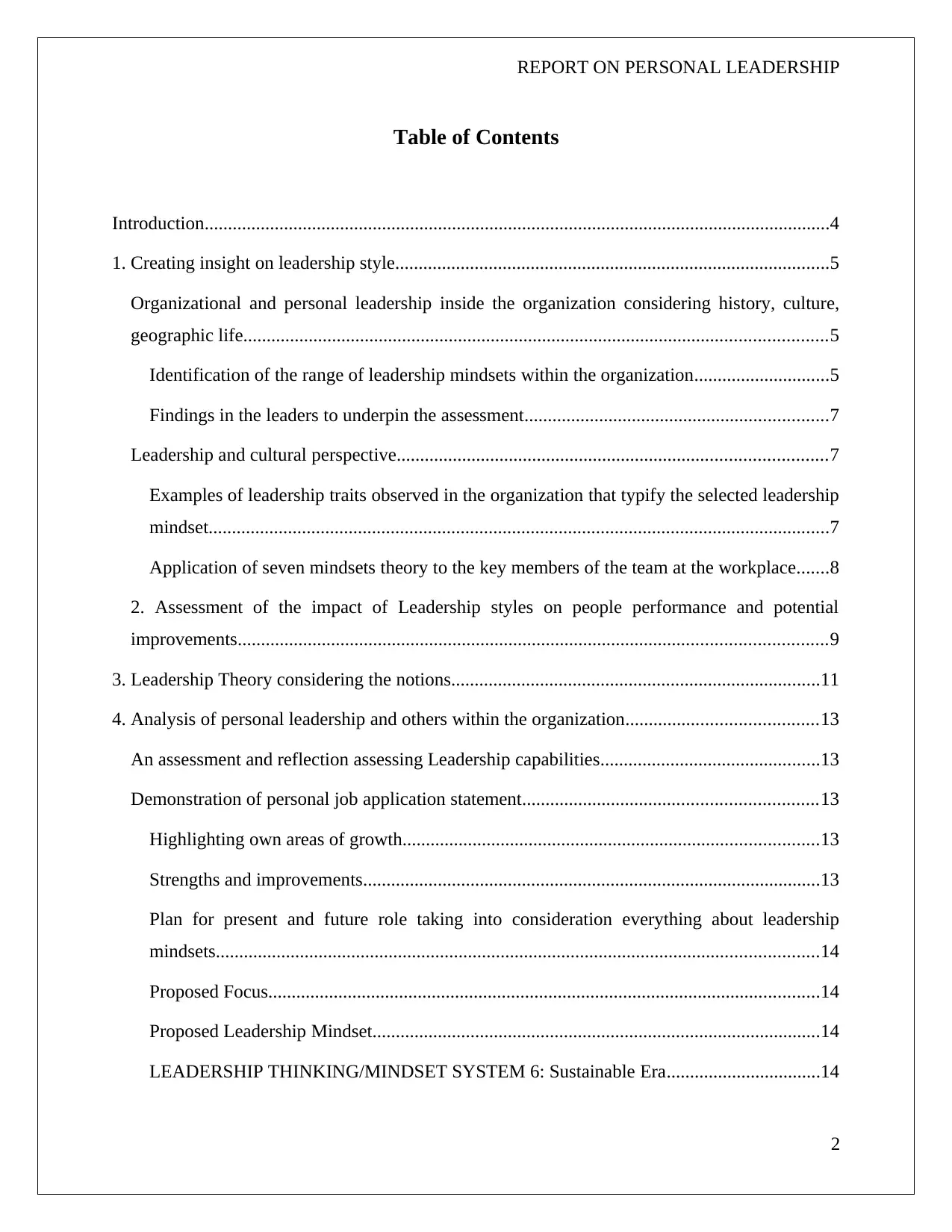
REPORT ON PERSONAL LEADERSHIP
Table of Contents
Introduction......................................................................................................................................4
1. Creating insight on leadership style.............................................................................................5
Organizational and personal leadership inside the organization considering history, culture,
geographic life.............................................................................................................................5
Identification of the range of leadership mindsets within the organization.............................5
Findings in the leaders to underpin the assessment.................................................................7
Leadership and cultural perspective............................................................................................7
Examples of leadership traits observed in the organization that typify the selected leadership
mindset.....................................................................................................................................7
Application of seven mindsets theory to the key members of the team at the workplace.......8
2. Assessment of the impact of Leadership styles on people performance and potential
improvements..............................................................................................................................9
3. Leadership Theory considering the notions...............................................................................11
4. Analysis of personal leadership and others within the organization.........................................13
An assessment and reflection assessing Leadership capabilities...............................................13
Demonstration of personal job application statement...............................................................13
Highlighting own areas of growth.........................................................................................13
Strengths and improvements..................................................................................................13
Plan for present and future role taking into consideration everything about leadership
mindsets.................................................................................................................................14
Proposed Focus......................................................................................................................14
Proposed Leadership Mindset................................................................................................14
LEADERSHIP THINKING/MINDSET SYSTEM 6: Sustainable Era.................................14
2
Table of Contents
Introduction......................................................................................................................................4
1. Creating insight on leadership style.............................................................................................5
Organizational and personal leadership inside the organization considering history, culture,
geographic life.............................................................................................................................5
Identification of the range of leadership mindsets within the organization.............................5
Findings in the leaders to underpin the assessment.................................................................7
Leadership and cultural perspective............................................................................................7
Examples of leadership traits observed in the organization that typify the selected leadership
mindset.....................................................................................................................................7
Application of seven mindsets theory to the key members of the team at the workplace.......8
2. Assessment of the impact of Leadership styles on people performance and potential
improvements..............................................................................................................................9
3. Leadership Theory considering the notions...............................................................................11
4. Analysis of personal leadership and others within the organization.........................................13
An assessment and reflection assessing Leadership capabilities...............................................13
Demonstration of personal job application statement...............................................................13
Highlighting own areas of growth.........................................................................................13
Strengths and improvements..................................................................................................13
Plan for present and future role taking into consideration everything about leadership
mindsets.................................................................................................................................14
Proposed Focus......................................................................................................................14
Proposed Leadership Mindset................................................................................................14
LEADERSHIP THINKING/MINDSET SYSTEM 6: Sustainable Era.................................14
2
⊘ This is a preview!⊘
Do you want full access?
Subscribe today to unlock all pages.

Trusted by 1+ million students worldwide
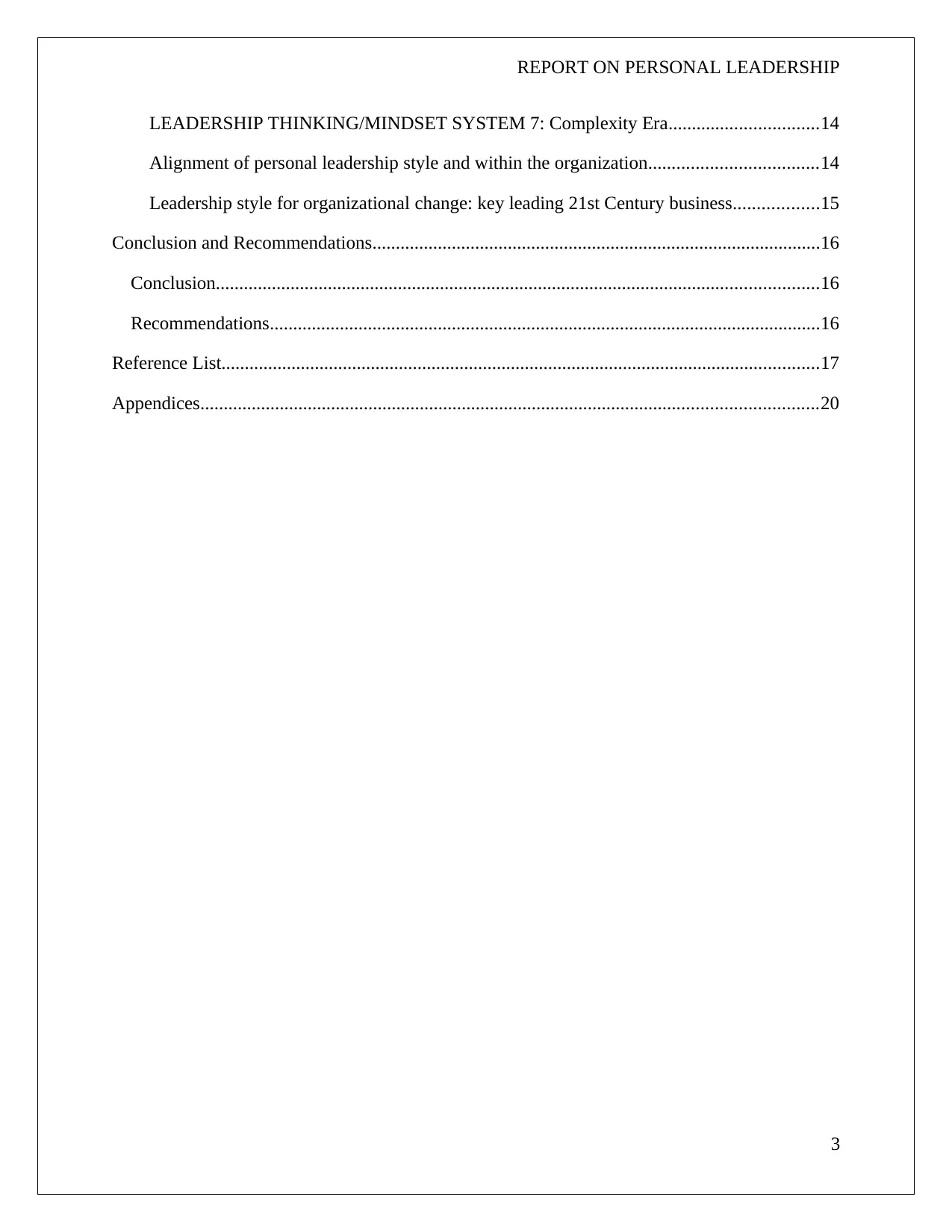
REPORT ON PERSONAL LEADERSHIP
LEADERSHIP THINKING/MINDSET SYSTEM 7: Complexity Era................................14
Alignment of personal leadership style and within the organization....................................14
Leadership style for organizational change: key leading 21st Century business..................15
Conclusion and Recommendations................................................................................................16
Conclusion.................................................................................................................................16
Recommendations......................................................................................................................16
Reference List................................................................................................................................17
Appendices....................................................................................................................................20
3
LEADERSHIP THINKING/MINDSET SYSTEM 7: Complexity Era................................14
Alignment of personal leadership style and within the organization....................................14
Leadership style for organizational change: key leading 21st Century business..................15
Conclusion and Recommendations................................................................................................16
Conclusion.................................................................................................................................16
Recommendations......................................................................................................................16
Reference List................................................................................................................................17
Appendices....................................................................................................................................20
3
Paraphrase This Document
Need a fresh take? Get an instant paraphrase of this document with our AI Paraphraser
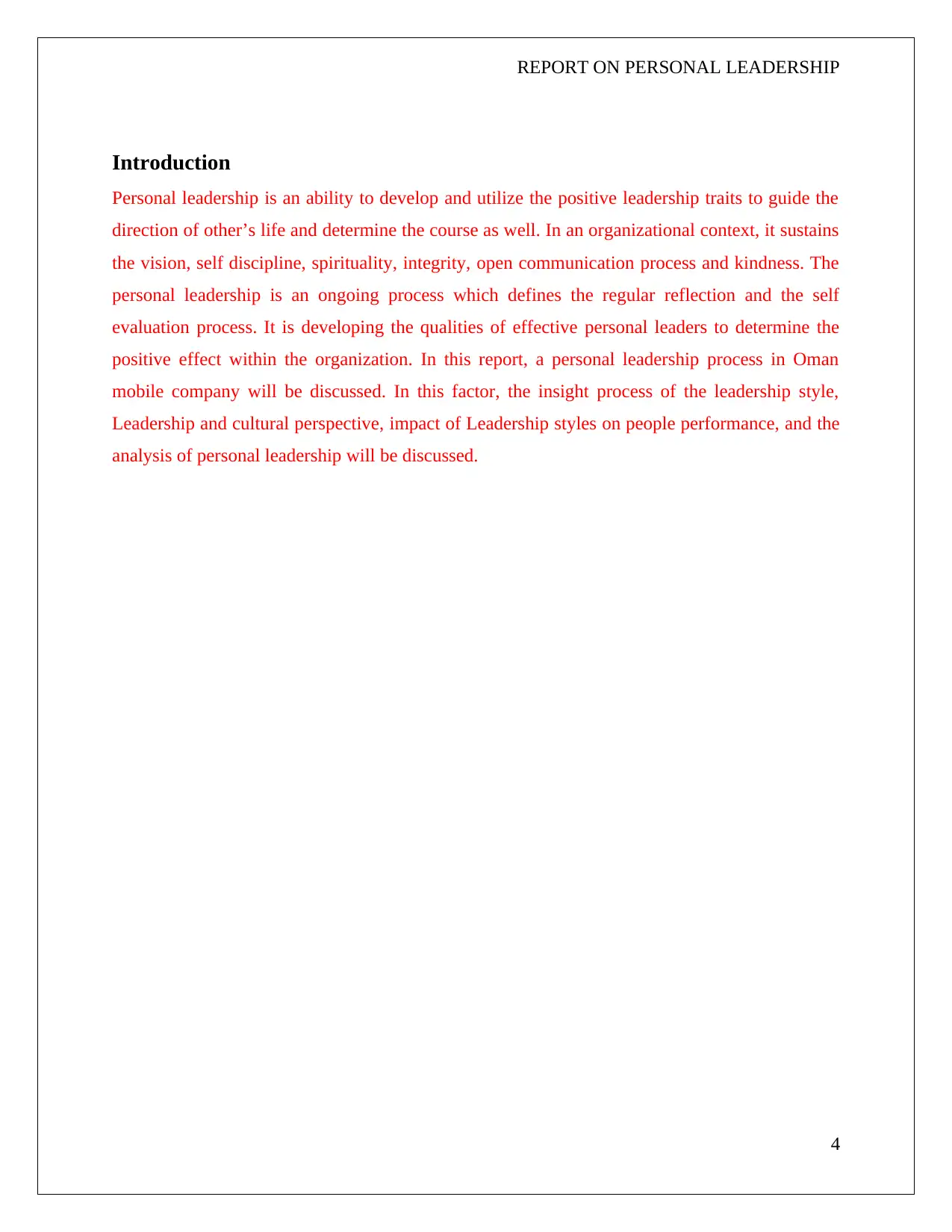
REPORT ON PERSONAL LEADERSHIP
Introduction
Personal leadership is an ability to develop and utilize the positive leadership traits to guide the
direction of other’s life and determine the course as well. In an organizational context, it sustains
the vision, self discipline, spirituality, integrity, open communication process and kindness. The
personal leadership is an ongoing process which defines the regular reflection and the self
evaluation process. It is developing the qualities of effective personal leaders to determine the
positive effect within the organization. In this report, a personal leadership process in Oman
mobile company will be discussed. In this factor, the insight process of the leadership style,
Leadership and cultural perspective, impact of Leadership styles on people performance, and the
analysis of personal leadership will be discussed.
4
Introduction
Personal leadership is an ability to develop and utilize the positive leadership traits to guide the
direction of other’s life and determine the course as well. In an organizational context, it sustains
the vision, self discipline, spirituality, integrity, open communication process and kindness. The
personal leadership is an ongoing process which defines the regular reflection and the self
evaluation process. It is developing the qualities of effective personal leaders to determine the
positive effect within the organization. In this report, a personal leadership process in Oman
mobile company will be discussed. In this factor, the insight process of the leadership style,
Leadership and cultural perspective, impact of Leadership styles on people performance, and the
analysis of personal leadership will be discussed.
4
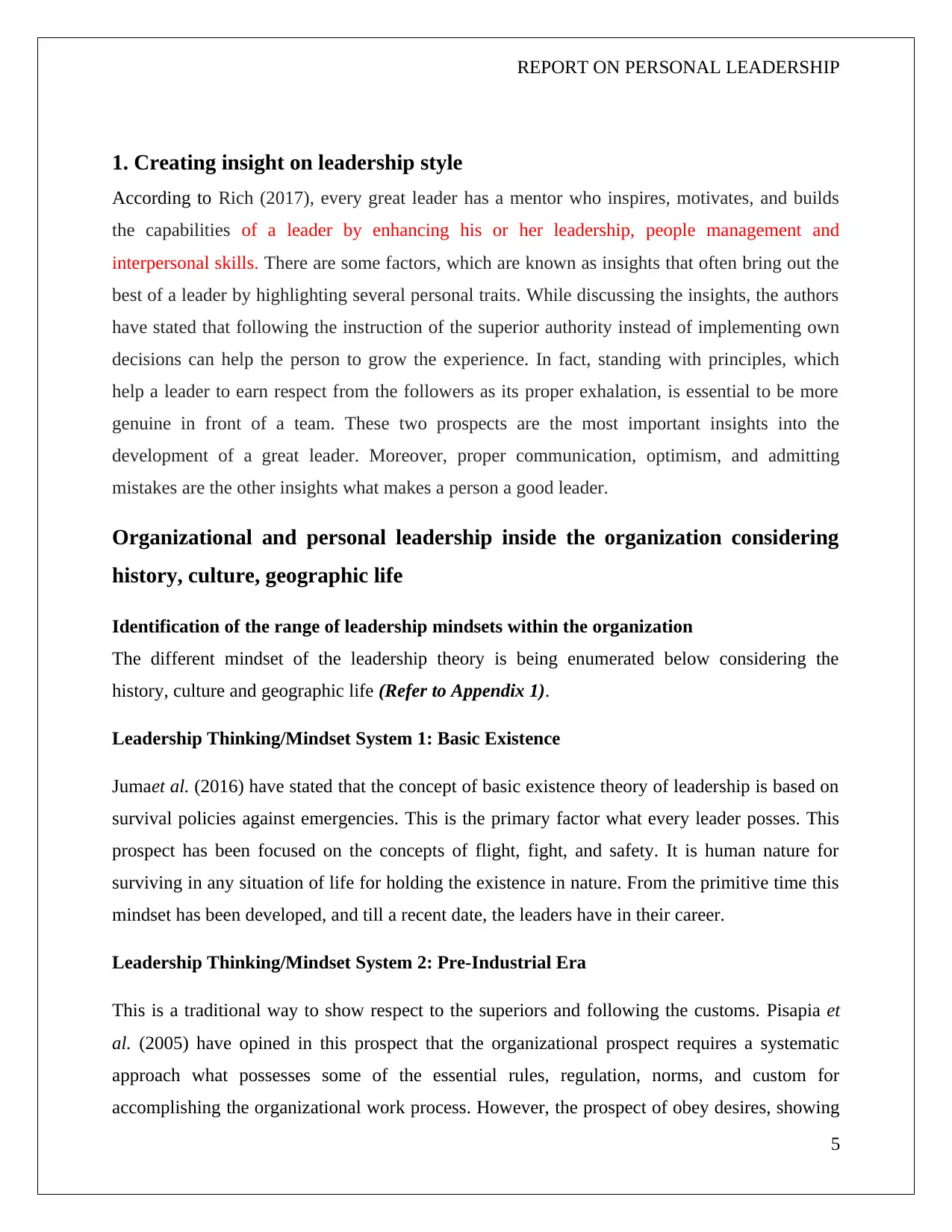
REPORT ON PERSONAL LEADERSHIP
1. Creating insight on leadership style
According to Rich (2017), every great leader has a mentor who inspires, motivates, and builds
the capabilities of a leader by enhancing his or her leadership, people management and
interpersonal skills. There are some factors, which are known as insights that often bring out the
best of a leader by highlighting several personal traits. While discussing the insights, the authors
have stated that following the instruction of the superior authority instead of implementing own
decisions can help the person to grow the experience. In fact, standing with principles, which
help a leader to earn respect from the followers as its proper exhalation, is essential to be more
genuine in front of a team. These two prospects are the most important insights into the
development of a great leader. Moreover, proper communication, optimism, and admitting
mistakes are the other insights what makes a person a good leader.
Organizational and personal leadership inside the organization considering
history, culture, geographic life
Identification of the range of leadership mindsets within the organization
The different mindset of the leadership theory is being enumerated below considering the
history, culture and geographic life (Refer to Appendix 1).
Leadership Thinking/Mindset System 1: Basic Existence
Jumaet al. (2016) have stated that the concept of basic existence theory of leadership is based on
survival policies against emergencies. This is the primary factor what every leader posses. This
prospect has been focused on the concepts of flight, fight, and safety. It is human nature for
surviving in any situation of life for holding the existence in nature. From the primitive time this
mindset has been developed, and till a recent date, the leaders have in their career.
Leadership Thinking/Mindset System 2: Pre-Industrial Era
This is a traditional way to show respect to the superiors and following the customs. Pisapia et
al. (2005) have opined in this prospect that the organizational prospect requires a systematic
approach what possesses some of the essential rules, regulation, norms, and custom for
accomplishing the organizational work process. However, the prospect of obey desires, showing
5
1. Creating insight on leadership style
According to Rich (2017), every great leader has a mentor who inspires, motivates, and builds
the capabilities of a leader by enhancing his or her leadership, people management and
interpersonal skills. There are some factors, which are known as insights that often bring out the
best of a leader by highlighting several personal traits. While discussing the insights, the authors
have stated that following the instruction of the superior authority instead of implementing own
decisions can help the person to grow the experience. In fact, standing with principles, which
help a leader to earn respect from the followers as its proper exhalation, is essential to be more
genuine in front of a team. These two prospects are the most important insights into the
development of a great leader. Moreover, proper communication, optimism, and admitting
mistakes are the other insights what makes a person a good leader.
Organizational and personal leadership inside the organization considering
history, culture, geographic life
Identification of the range of leadership mindsets within the organization
The different mindset of the leadership theory is being enumerated below considering the
history, culture and geographic life (Refer to Appendix 1).
Leadership Thinking/Mindset System 1: Basic Existence
Jumaet al. (2016) have stated that the concept of basic existence theory of leadership is based on
survival policies against emergencies. This is the primary factor what every leader posses. This
prospect has been focused on the concepts of flight, fight, and safety. It is human nature for
surviving in any situation of life for holding the existence in nature. From the primitive time this
mindset has been developed, and till a recent date, the leaders have in their career.
Leadership Thinking/Mindset System 2: Pre-Industrial Era
This is a traditional way to show respect to the superiors and following the customs. Pisapia et
al. (2005) have opined in this prospect that the organizational prospect requires a systematic
approach what possesses some of the essential rules, regulation, norms, and custom for
accomplishing the organizational work process. However, the prospect of obey desires, showing
5
⊘ This is a preview!⊘
Do you want full access?
Subscribe today to unlock all pages.

Trusted by 1+ million students worldwide
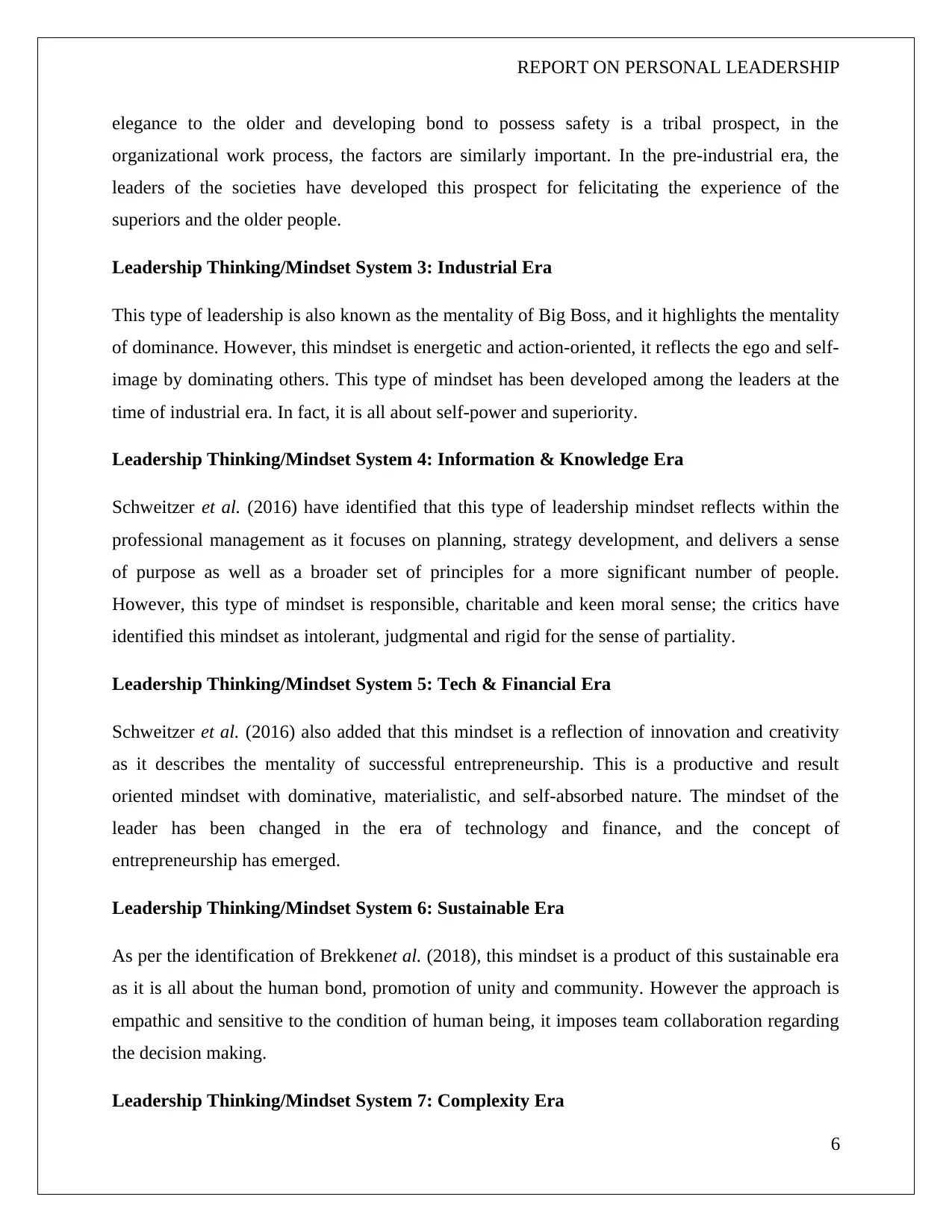
REPORT ON PERSONAL LEADERSHIP
elegance to the older and developing bond to possess safety is a tribal prospect, in the
organizational work process, the factors are similarly important. In the pre-industrial era, the
leaders of the societies have developed this prospect for felicitating the experience of the
superiors and the older people.
Leadership Thinking/Mindset System 3: Industrial Era
This type of leadership is also known as the mentality of Big Boss, and it highlights the mentality
of dominance. However, this mindset is energetic and action-oriented, it reflects the ego and self-
image by dominating others. This type of mindset has been developed among the leaders at the
time of industrial era. In fact, it is all about self-power and superiority.
Leadership Thinking/Mindset System 4: Information & Knowledge Era
Schweitzer et al. (2016) have identified that this type of leadership mindset reflects within the
professional management as it focuses on planning, strategy development, and delivers a sense
of purpose as well as a broader set of principles for a more significant number of people.
However, this type of mindset is responsible, charitable and keen moral sense; the critics have
identified this mindset as intolerant, judgmental and rigid for the sense of partiality.
Leadership Thinking/Mindset System 5: Tech & Financial Era
Schweitzer et al. (2016) also added that this mindset is a reflection of innovation and creativity
as it describes the mentality of successful entrepreneurship. This is a productive and result
oriented mindset with dominative, materialistic, and self-absorbed nature. The mindset of the
leader has been changed in the era of technology and finance, and the concept of
entrepreneurship has emerged.
Leadership Thinking/Mindset System 6: Sustainable Era
As per the identification of Brekkenet al. (2018), this mindset is a product of this sustainable era
as it is all about the human bond, promotion of unity and community. However the approach is
empathic and sensitive to the condition of human being, it imposes team collaboration regarding
the decision making.
Leadership Thinking/Mindset System 7: Complexity Era
6
elegance to the older and developing bond to possess safety is a tribal prospect, in the
organizational work process, the factors are similarly important. In the pre-industrial era, the
leaders of the societies have developed this prospect for felicitating the experience of the
superiors and the older people.
Leadership Thinking/Mindset System 3: Industrial Era
This type of leadership is also known as the mentality of Big Boss, and it highlights the mentality
of dominance. However, this mindset is energetic and action-oriented, it reflects the ego and self-
image by dominating others. This type of mindset has been developed among the leaders at the
time of industrial era. In fact, it is all about self-power and superiority.
Leadership Thinking/Mindset System 4: Information & Knowledge Era
Schweitzer et al. (2016) have identified that this type of leadership mindset reflects within the
professional management as it focuses on planning, strategy development, and delivers a sense
of purpose as well as a broader set of principles for a more significant number of people.
However, this type of mindset is responsible, charitable and keen moral sense; the critics have
identified this mindset as intolerant, judgmental and rigid for the sense of partiality.
Leadership Thinking/Mindset System 5: Tech & Financial Era
Schweitzer et al. (2016) also added that this mindset is a reflection of innovation and creativity
as it describes the mentality of successful entrepreneurship. This is a productive and result
oriented mindset with dominative, materialistic, and self-absorbed nature. The mindset of the
leader has been changed in the era of technology and finance, and the concept of
entrepreneurship has emerged.
Leadership Thinking/Mindset System 6: Sustainable Era
As per the identification of Brekkenet al. (2018), this mindset is a product of this sustainable era
as it is all about the human bond, promotion of unity and community. However the approach is
empathic and sensitive to the condition of human being, it imposes team collaboration regarding
the decision making.
Leadership Thinking/Mindset System 7: Complexity Era
6
Paraphrase This Document
Need a fresh take? Get an instant paraphrase of this document with our AI Paraphraser
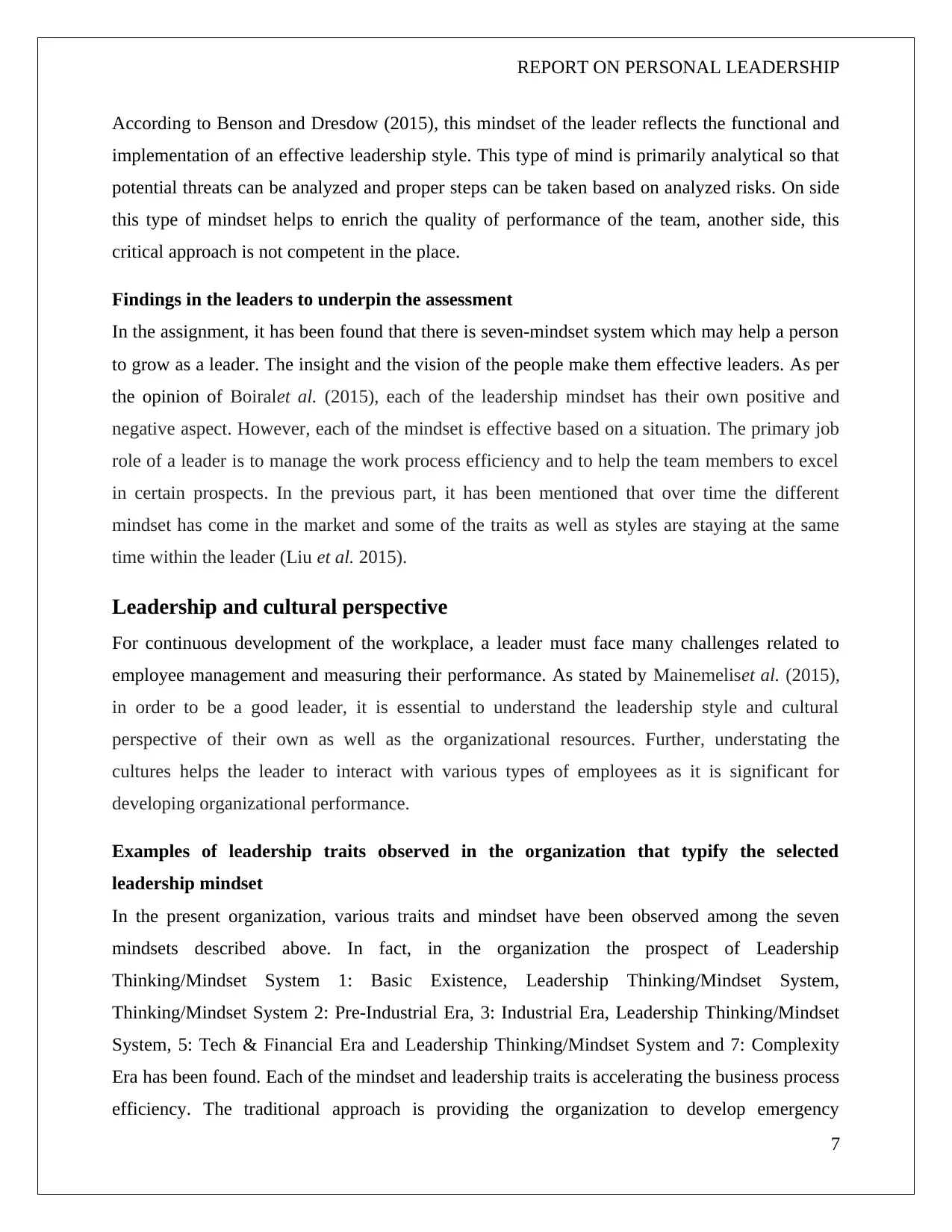
REPORT ON PERSONAL LEADERSHIP
According to Benson and Dresdow (2015), this mindset of the leader reflects the functional and
implementation of an effective leadership style. This type of mind is primarily analytical so that
potential threats can be analyzed and proper steps can be taken based on analyzed risks. On side
this type of mindset helps to enrich the quality of performance of the team, another side, this
critical approach is not competent in the place.
Findings in the leaders to underpin the assessment
In the assignment, it has been found that there is seven-mindset system which may help a person
to grow as a leader. The insight and the vision of the people make them effective leaders. As per
the opinion of Boiralet al. (2015), each of the leadership mindset has their own positive and
negative aspect. However, each of the mindset is effective based on a situation. The primary job
role of a leader is to manage the work process efficiency and to help the team members to excel
in certain prospects. In the previous part, it has been mentioned that over time the different
mindset has come in the market and some of the traits as well as styles are staying at the same
time within the leader (Liu et al. 2015).
Leadership and cultural perspective
For continuous development of the workplace, a leader must face many challenges related to
employee management and measuring their performance. As stated by Mainemeliset al. (2015),
in order to be a good leader, it is essential to understand the leadership style and cultural
perspective of their own as well as the organizational resources. Further, understating the
cultures helps the leader to interact with various types of employees as it is significant for
developing organizational performance.
Examples of leadership traits observed in the organization that typify the selected
leadership mindset
In the present organization, various traits and mindset have been observed among the seven
mindsets described above. In fact, in the organization the prospect of Leadership
Thinking/Mindset System 1: Basic Existence, Leadership Thinking/Mindset System,
Thinking/Mindset System 2: Pre-Industrial Era, 3: Industrial Era, Leadership Thinking/Mindset
System, 5: Tech & Financial Era and Leadership Thinking/Mindset System and 7: Complexity
Era has been found. Each of the mindset and leadership traits is accelerating the business process
efficiency. The traditional approach is providing the organization to develop emergency
7
According to Benson and Dresdow (2015), this mindset of the leader reflects the functional and
implementation of an effective leadership style. This type of mind is primarily analytical so that
potential threats can be analyzed and proper steps can be taken based on analyzed risks. On side
this type of mindset helps to enrich the quality of performance of the team, another side, this
critical approach is not competent in the place.
Findings in the leaders to underpin the assessment
In the assignment, it has been found that there is seven-mindset system which may help a person
to grow as a leader. The insight and the vision of the people make them effective leaders. As per
the opinion of Boiralet al. (2015), each of the leadership mindset has their own positive and
negative aspect. However, each of the mindset is effective based on a situation. The primary job
role of a leader is to manage the work process efficiency and to help the team members to excel
in certain prospects. In the previous part, it has been mentioned that over time the different
mindset has come in the market and some of the traits as well as styles are staying at the same
time within the leader (Liu et al. 2015).
Leadership and cultural perspective
For continuous development of the workplace, a leader must face many challenges related to
employee management and measuring their performance. As stated by Mainemeliset al. (2015),
in order to be a good leader, it is essential to understand the leadership style and cultural
perspective of their own as well as the organizational resources. Further, understating the
cultures helps the leader to interact with various types of employees as it is significant for
developing organizational performance.
Examples of leadership traits observed in the organization that typify the selected
leadership mindset
In the present organization, various traits and mindset have been observed among the seven
mindsets described above. In fact, in the organization the prospect of Leadership
Thinking/Mindset System 1: Basic Existence, Leadership Thinking/Mindset System,
Thinking/Mindset System 2: Pre-Industrial Era, 3: Industrial Era, Leadership Thinking/Mindset
System, 5: Tech & Financial Era and Leadership Thinking/Mindset System and 7: Complexity
Era has been found. Each of the mindset and leadership traits is accelerating the business process
efficiency. The traditional approach is providing the organization to develop emergency
7
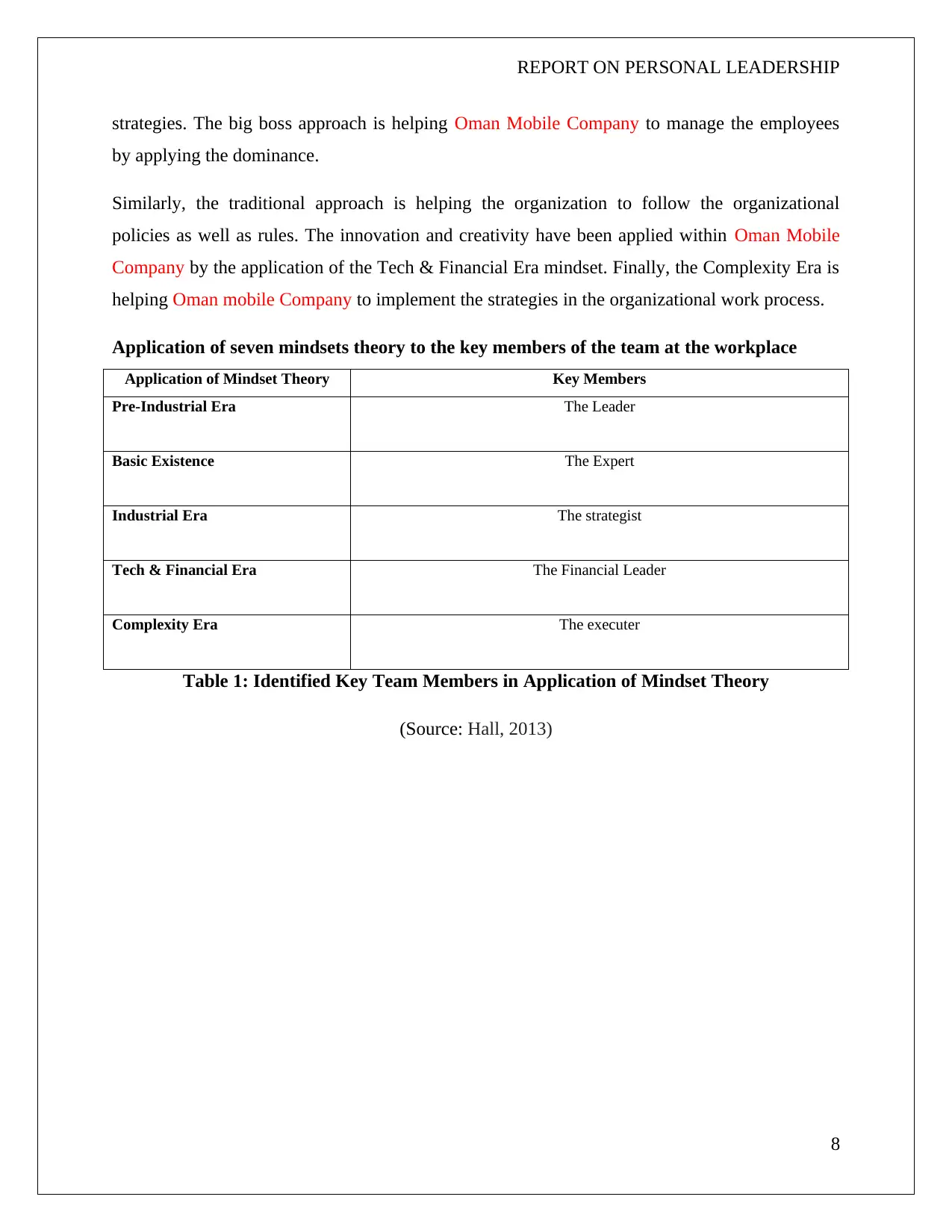
REPORT ON PERSONAL LEADERSHIP
strategies. The big boss approach is helping Oman Mobile Company to manage the employees
by applying the dominance.
Similarly, the traditional approach is helping the organization to follow the organizational
policies as well as rules. The innovation and creativity have been applied within Oman Mobile
Company by the application of the Tech & Financial Era mindset. Finally, the Complexity Era is
helping Oman mobile Company to implement the strategies in the organizational work process.
Application of seven mindsets theory to the key members of the team at the workplace
Application of Mindset Theory Key Members
Pre-Industrial Era The Leader
Basic Existence The Expert
Industrial Era The strategist
Tech & Financial Era The Financial Leader
Complexity Era The executer
Table 1: Identified Key Team Members in Application of Mindset Theory
(Source: Hall, 2013)
8
strategies. The big boss approach is helping Oman Mobile Company to manage the employees
by applying the dominance.
Similarly, the traditional approach is helping the organization to follow the organizational
policies as well as rules. The innovation and creativity have been applied within Oman Mobile
Company by the application of the Tech & Financial Era mindset. Finally, the Complexity Era is
helping Oman mobile Company to implement the strategies in the organizational work process.
Application of seven mindsets theory to the key members of the team at the workplace
Application of Mindset Theory Key Members
Pre-Industrial Era The Leader
Basic Existence The Expert
Industrial Era The strategist
Tech & Financial Era The Financial Leader
Complexity Era The executer
Table 1: Identified Key Team Members in Application of Mindset Theory
(Source: Hall, 2013)
8
⊘ This is a preview!⊘
Do you want full access?
Subscribe today to unlock all pages.

Trusted by 1+ million students worldwide
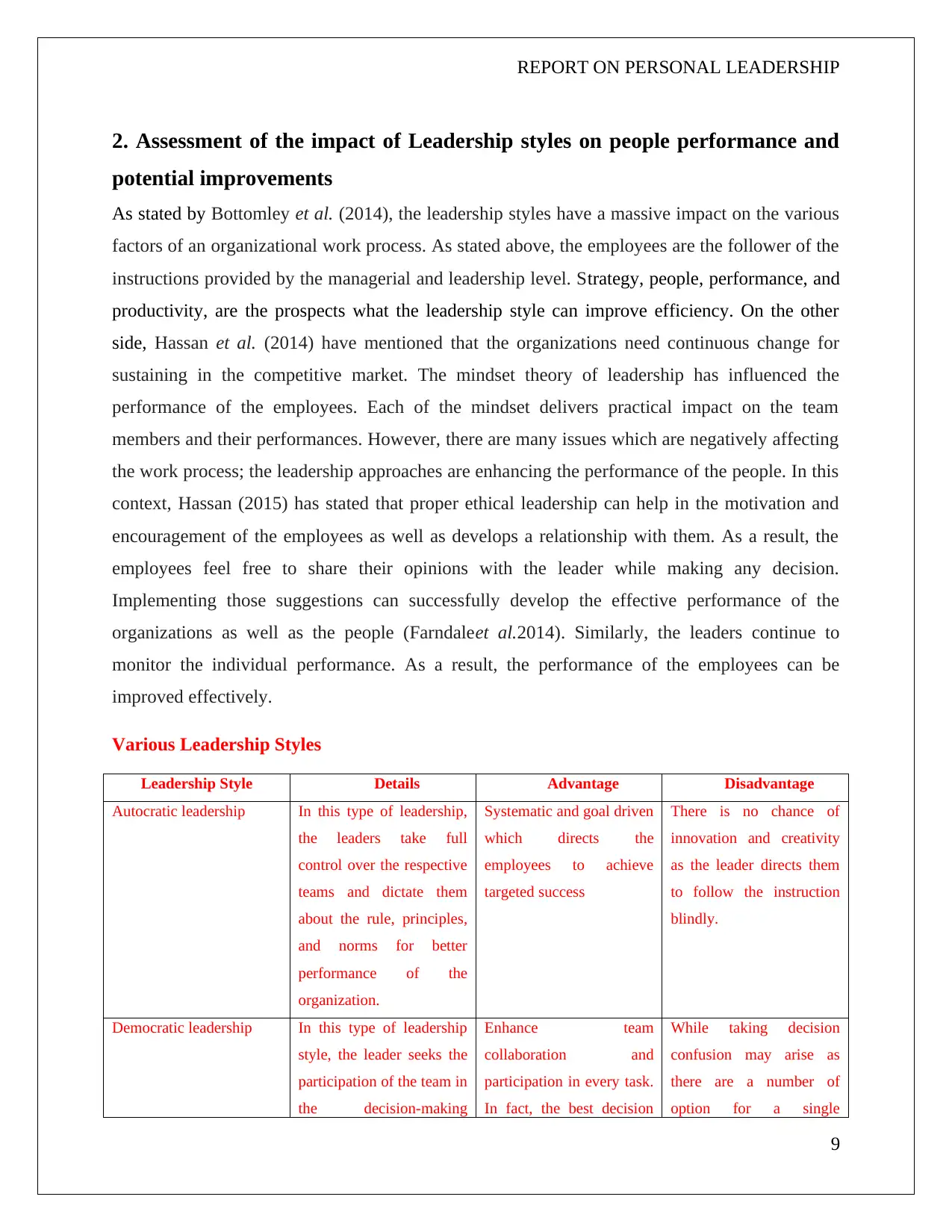
REPORT ON PERSONAL LEADERSHIP
2. Assessment of the impact of Leadership styles on people performance and
potential improvements
As stated by Bottomley et al. (2014), the leadership styles have a massive impact on the various
factors of an organizational work process. As stated above, the employees are the follower of the
instructions provided by the managerial and leadership level. Strategy, people, performance, and
productivity, are the prospects what the leadership style can improve efficiency. On the other
side, Hassan et al. (2014) have mentioned that the organizations need continuous change for
sustaining in the competitive market. The mindset theory of leadership has influenced the
performance of the employees. Each of the mindset delivers practical impact on the team
members and their performances. However, there are many issues which are negatively affecting
the work process; the leadership approaches are enhancing the performance of the people. In this
context, Hassan (2015) has stated that proper ethical leadership can help in the motivation and
encouragement of the employees as well as develops a relationship with them. As a result, the
employees feel free to share their opinions with the leader while making any decision.
Implementing those suggestions can successfully develop the effective performance of the
organizations as well as the people (Farndaleet al.2014). Similarly, the leaders continue to
monitor the individual performance. As a result, the performance of the employees can be
improved effectively.
Various Leadership Styles
Leadership Style Details Advantage Disadvantage
Autocratic leadership In this type of leadership,
the leaders take full
control over the respective
teams and dictate them
about the rule, principles,
and norms for better
performance of the
organization.
Systematic and goal driven
which directs the
employees to achieve
targeted success
There is no chance of
innovation and creativity
as the leader directs them
to follow the instruction
blindly.
Democratic leadership In this type of leadership
style, the leader seeks the
participation of the team in
the decision-making
Enhance team
collaboration and
participation in every task.
In fact, the best decision
While taking decision
confusion may arise as
there are a number of
option for a single
9
2. Assessment of the impact of Leadership styles on people performance and
potential improvements
As stated by Bottomley et al. (2014), the leadership styles have a massive impact on the various
factors of an organizational work process. As stated above, the employees are the follower of the
instructions provided by the managerial and leadership level. Strategy, people, performance, and
productivity, are the prospects what the leadership style can improve efficiency. On the other
side, Hassan et al. (2014) have mentioned that the organizations need continuous change for
sustaining in the competitive market. The mindset theory of leadership has influenced the
performance of the employees. Each of the mindset delivers practical impact on the team
members and their performances. However, there are many issues which are negatively affecting
the work process; the leadership approaches are enhancing the performance of the people. In this
context, Hassan (2015) has stated that proper ethical leadership can help in the motivation and
encouragement of the employees as well as develops a relationship with them. As a result, the
employees feel free to share their opinions with the leader while making any decision.
Implementing those suggestions can successfully develop the effective performance of the
organizations as well as the people (Farndaleet al.2014). Similarly, the leaders continue to
monitor the individual performance. As a result, the performance of the employees can be
improved effectively.
Various Leadership Styles
Leadership Style Details Advantage Disadvantage
Autocratic leadership In this type of leadership,
the leaders take full
control over the respective
teams and dictate them
about the rule, principles,
and norms for better
performance of the
organization.
Systematic and goal driven
which directs the
employees to achieve
targeted success
There is no chance of
innovation and creativity
as the leader directs them
to follow the instruction
blindly.
Democratic leadership In this type of leadership
style, the leader seeks the
participation of the team in
the decision-making
Enhance team
collaboration and
participation in every task.
In fact, the best decision
While taking decision
confusion may arise as
there are a number of
option for a single
9
Paraphrase This Document
Need a fresh take? Get an instant paraphrase of this document with our AI Paraphraser
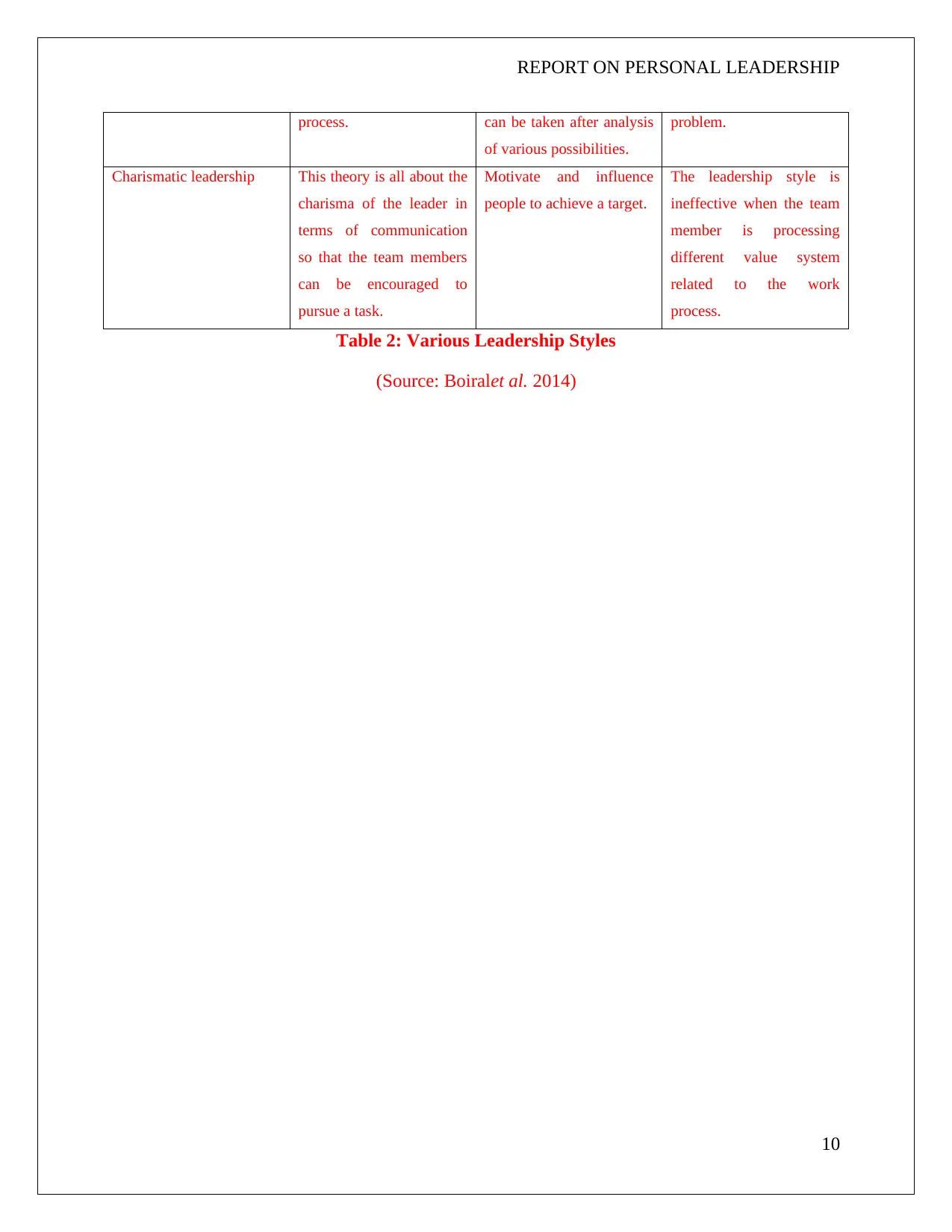
REPORT ON PERSONAL LEADERSHIP
process. can be taken after analysis
of various possibilities.
problem.
Charismatic leadership This theory is all about the
charisma of the leader in
terms of communication
so that the team members
can be encouraged to
pursue a task.
Motivate and influence
people to achieve a target.
The leadership style is
ineffective when the team
member is processing
different value system
related to the work
process.
Table 2: Various Leadership Styles
(Source: Boiralet al. 2014)
10
process. can be taken after analysis
of various possibilities.
problem.
Charismatic leadership This theory is all about the
charisma of the leader in
terms of communication
so that the team members
can be encouraged to
pursue a task.
Motivate and influence
people to achieve a target.
The leadership style is
ineffective when the team
member is processing
different value system
related to the work
process.
Table 2: Various Leadership Styles
(Source: Boiralet al. 2014)
10
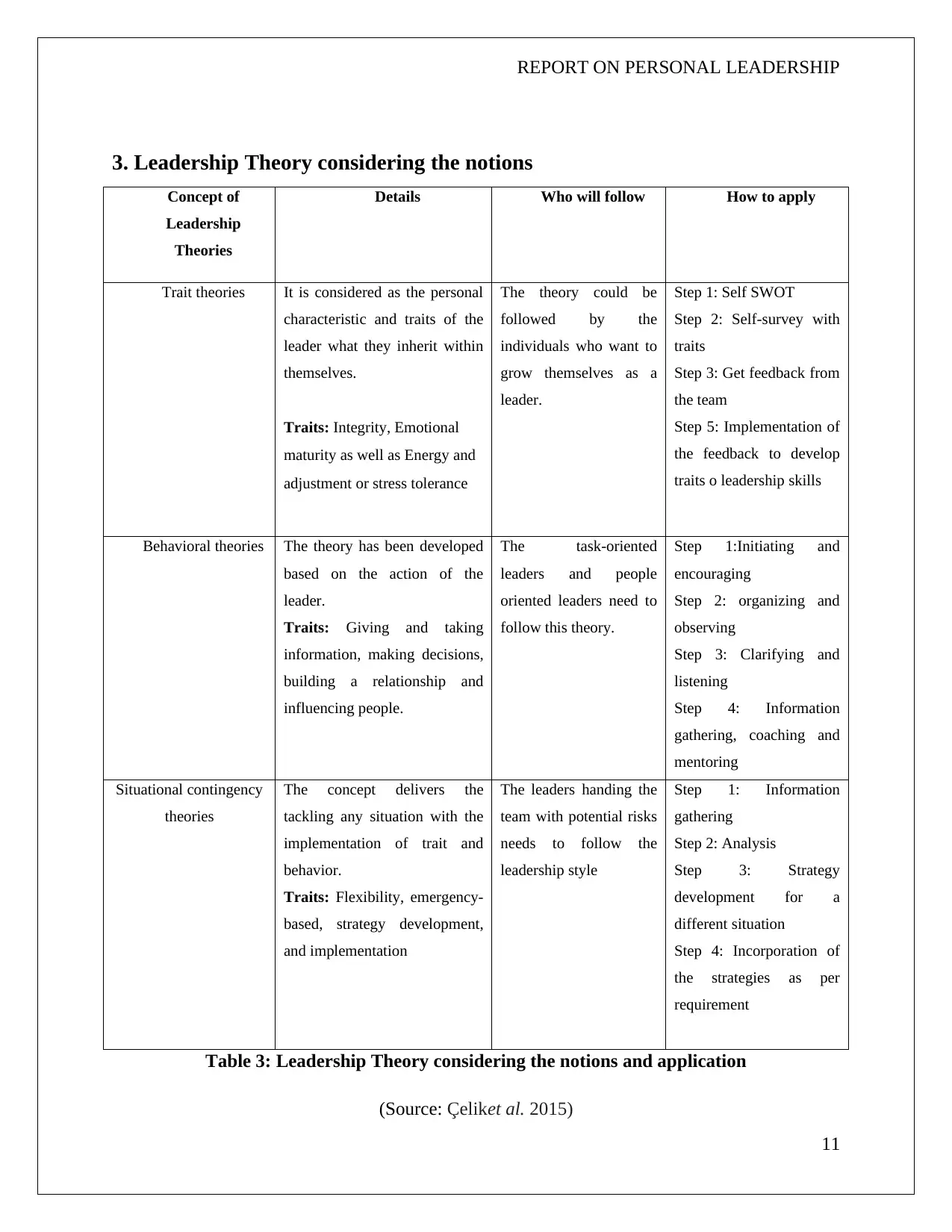
REPORT ON PERSONAL LEADERSHIP
3. Leadership Theory considering the notions
Concept of
Leadership
Theories
Details Who will follow How to apply
Trait theories It is considered as the personal
characteristic and traits of the
leader what they inherit within
themselves.
Traits: Integrity, Emotional
maturity as well as Energy and
adjustment or stress tolerance
The theory could be
followed by the
individuals who want to
grow themselves as a
leader.
Step 1: Self SWOT
Step 2: Self-survey with
traits
Step 3: Get feedback from
the team
Step 5: Implementation of
the feedback to develop
traits o leadership skills
Behavioral theories The theory has been developed
based on the action of the
leader.
Traits: Giving and taking
information, making decisions,
building a relationship and
influencing people.
The task-oriented
leaders and people
oriented leaders need to
follow this theory.
Step 1:Initiating and
encouraging
Step 2: organizing and
observing
Step 3: Clarifying and
listening
Step 4: Information
gathering, coaching and
mentoring
Situational contingency
theories
The concept delivers the
tackling any situation with the
implementation of trait and
behavior.
Traits: Flexibility, emergency-
based, strategy development,
and implementation
The leaders handing the
team with potential risks
needs to follow the
leadership style
Step 1: Information
gathering
Step 2: Analysis
Step 3: Strategy
development for a
different situation
Step 4: Incorporation of
the strategies as per
requirement
Table 3: Leadership Theory considering the notions and application
(Source: Çeliket al. 2015)
11
3. Leadership Theory considering the notions
Concept of
Leadership
Theories
Details Who will follow How to apply
Trait theories It is considered as the personal
characteristic and traits of the
leader what they inherit within
themselves.
Traits: Integrity, Emotional
maturity as well as Energy and
adjustment or stress tolerance
The theory could be
followed by the
individuals who want to
grow themselves as a
leader.
Step 1: Self SWOT
Step 2: Self-survey with
traits
Step 3: Get feedback from
the team
Step 5: Implementation of
the feedback to develop
traits o leadership skills
Behavioral theories The theory has been developed
based on the action of the
leader.
Traits: Giving and taking
information, making decisions,
building a relationship and
influencing people.
The task-oriented
leaders and people
oriented leaders need to
follow this theory.
Step 1:Initiating and
encouraging
Step 2: organizing and
observing
Step 3: Clarifying and
listening
Step 4: Information
gathering, coaching and
mentoring
Situational contingency
theories
The concept delivers the
tackling any situation with the
implementation of trait and
behavior.
Traits: Flexibility, emergency-
based, strategy development,
and implementation
The leaders handing the
team with potential risks
needs to follow the
leadership style
Step 1: Information
gathering
Step 2: Analysis
Step 3: Strategy
development for a
different situation
Step 4: Incorporation of
the strategies as per
requirement
Table 3: Leadership Theory considering the notions and application
(Source: Çeliket al. 2015)
11
⊘ This is a preview!⊘
Do you want full access?
Subscribe today to unlock all pages.

Trusted by 1+ million students worldwide
1 out of 21
Related Documents
Your All-in-One AI-Powered Toolkit for Academic Success.
+13062052269
info@desklib.com
Available 24*7 on WhatsApp / Email
![[object Object]](/_next/static/media/star-bottom.7253800d.svg)
Unlock your academic potential
Copyright © 2020–2025 A2Z Services. All Rights Reserved. Developed and managed by ZUCOL.




